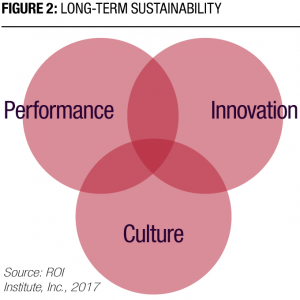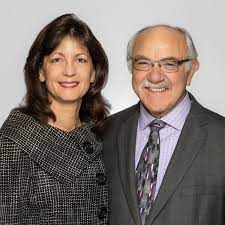 Many chief learning officers have earned a seat at the table where decisions are made, strategies are developed and key challenges are discussed. It’s time to take the CLO role to a higher level, not just on the organization chart, but in terms of influence and organizational accomplishment.
Many chief learning officers have earned a seat at the table where decisions are made, strategies are developed and key challenges are discussed. It’s time to take the CLO role to a higher level, not just on the organization chart, but in terms of influence and organizational accomplishment.
In most organizations, earning the C-suite title automatically earns a seat at the table. But the “chief” title isn’t given out loosely. It’s reserved for individuals in key functional roles that add business value. CLOs have earned a seat because more learning leaders are adding and measuring business value. Chief Learning Officer’s “2015 CLO Measurement and Metrics Survey” indicated that 36 percent of CLOs are using business impact to show the value of learning to the broader enterprise. Twenty-two percent are using ROI for the same goal. In all, 72 percent are either using or plan to use ROI in the future as a tool to show impact.
Also, the CLO is responsible for talent development. Talent is important, and its importance is increasing in the global business environment. Having the right talent can add to market value and be a key source of competitive advantage. Logically, the person responsible for talent development must have strategic input. There are five potential areas where the CLO can move beyond earning a seat at the table.
Focus on Value Creation
When it comes to delivering value and addressing accountability, much of the focus has been on capturing value, or evaluation, and reporting it so executives will respect, appreciate and use the learning function. While this is important, it is time to move from value capture to value creation with a focus on continuous program improvement.
One of the greatest challenges facing the CLO is the need to protect and enhance the budget. Evaluation program data exposes weaknesses and strengths. Using these data to improve processes enhances future program ROI and can lead to more funds. Instead of perceiving learning as a cost that can be controlled or reduced, this approach positions learning as an investment that will reap a positive return with credible, unmistakable results (see Figure 1). 
Expand Responsibilities
The scope and focus of the CLO role continues to evolve and expand. In recent years, many learning leaders have acquired five additional responsibilities:
Talent acquisition: It’s difficult to develop talent without ensuring the right talent selections have been made from the start. Acquisition should be part of the CLO role.
Talent management: The CLO should manage the complete talent life cycle, with a focus on talent retention. Nothing is more disappointing than developing key talent, only to have them leave because of issues beyond the CLOs’ responsibility. In consequence, many CLOs have assumed the chief talent officer role and all functional responsibilities within the talent management area.
Performance management: There is much debate about what a performance management system should be or even if there should be one. Performance management is important to organizational success and involves the formal performance review system — if there is one — and ways the organization can motivate and reward individuals to achieve performance. The CLO is in the best position to manage the performance system.
Innovation: Innovation separates mediocre from best-in-class organizations, and constant innovation promotes organizational growth and long-term sustainability. While innovation involves almost everyone and is driven from the top, learning is the best functional area from which to coordinate efforts because the learning leader is in tune with how to motivate employees, change habits and spark creativity.
Engagement: Engaged employees are more productive, produce better quality work, work more safely, are more efficient, deliver better customer service, and are more likely to stay with the organization. Engagement involves several different issues, including work design, workplace systems, goal setting, accountability and learning. Employees must learn to become productive team members, be accountable for their work, assume responsibility for goals and routinely communicate with colleagues. Engagement efforts are significant, and most organizations are constantly revamping their `engagement efforts, including the annual engagement survey. The CLO should be responsible for ensuring the process is working properly.
Drive Culture Change
Top executives know a strong culture can drive success, and when an organization has a strong culture it must be maintained to prevent it from eroding. Organizations that don’t have a clearly defined culture often want to change it. The intersection of performance, innovation and culture, depicted in Figure 2, represents a strong culture that drives innovation and performance, which is necessary for long-term sustainability. 
Changing, maintaining or recapturing a culture that has gone astray requires tremendous effort; it needs relentless focus from the top and throughout the organization. Learning is a key part of making that happen. What part of the organization is better suited to change the mindsets, attitudes, perceptions, thoughts and feelings than the learning and talent development function?
“Culture Change That Sticks,” a 2012 article in the Harvard Business Review, defined five core principles that must be followed to change a culture and make it stick that are still relevant today:
- Match the strategy with culture.
- Focus on a few critical shifts in behavior.
- Honor existing cultural strengths.
- Integrate formal and informal interventions.
- Measure and monitor cultural evolution.
The CLO is equipped with the resources and the skill sets to make this work. Using a variety of programs from formal learning sessions, e-learning, mobile learning, coaching, mentoring and a host of informal learning processes, the CLO can literally change mindsets, attitudes, beliefs, opinions and feelings in the workforce. Few other individuals have this key responsibility area in the organization.
Tackle Big Challenges
To keep their seat at the table, CLOs need to tackle three major challenges facing organizations. They are:
Developing global leaders: Trust in institutions and leaders in all types of organizations is eroding. Employees want outstanding leadership, and top leaders are struggling. According to PwC’s 2015 “CEO Success Study” of the 2,500 largest organizations, CEO turnover in 2015 was 16.6 percent, a record high. Company boards are now making a deliberate choice to bring in outsiders. From 2012-2015, boards chose outsiders in 22 percent of planned turnovers, up from 14 percent in 2004-2007. Further, the Global CEO is a myth. Just 28 percent of incoming CEOs had international work experience, down from 45 percent in 2012.
That lack of success can be laid at the talent development team’s doorstep. Now is the time to focus on this challenge. Leadership development requires more than just a learning program. It requires a clear understanding of what the business needs globally, and CLOs have to be prepared to implement a variety of initiatives, programs and actions to develop future global leaders. Further, leadership development success must be clearly measured so that executives see the connection to the business.
Working globally: Most organizations are either selling to the global market, buying from the global market, or both. Many have a large presence in other countries with plants, distribution centers, sales outlets and research centers. Too many international ventures have gone astray or have become inefficient because they don’t fit in with the global culture. These missteps can be avoided with proper planning and by executing with a global mindset and workforce. Development options must be global as well.
The future of work: Work is radically changing. Organizational success is not only about how the work is done, but where and when the work is performed. Communication is rapidly evolving, organizational structures are evolving, and technology-enabled processes are promoting radical change. The mindsets and skills needed today are different from what the current workforce presents. A serious skill gap exists. New employees need power skills for success in the workplace, such as communication, teamwork, collaboration, adaptability, conflict resolution, problem-solving and critical thinking. There is no better position in the organization than the chief learning officer to tackle this major challenge.
Be a Valued Business Partner
The capstone of thinking beyond that coveted seat at the table is to operate as an effective business partner. Sometimes the CLO is handed a seat at the table. To keep it and make that seat valuable will require great partnerships with all of an organization’s key leaders. This includes ensuring that the CLO and the learning team fully understand the business and the issues facing the organization.
The role of CLO is evolving to take on new duties, create more value and tackle important business challenges. Some CLOs have already moved to new titles such as chief talent officer or chief talent management officer as they expand roles and responsibilities, while simultaneously driving business value.
Business alignment is critical and should be achieved with most projects and programs. The business connection after program implementation should be clearly presented and specified. This will ensure that other business partners who have responsibility for driving business results, either in sales, IT, logistics or operations have a partner in the CLO, a partner they can trust to help them with major issues, drive major change, and deliver important results.
Jack J. Phillips is the chairman, and Patti P. Phillips is president and CEO of the ROI Institute. To comment email editor@CLOmedia.com.















